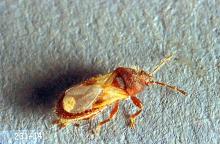Blissus spp.
Pest description and crop damage Small black bug, 0.18 inch in length, with characteristic white marks on wing covers. Nymphs are reddish with white or black markings. Chinch bugs are Hemipterans and as such have piercing and sucking mouth parts. They suck sap from the crown and stem of grasses. Because chinch bugs tend to aggregate, damage often occurs in clumps. Grass becomes yellow and dies. Chinch bug damage generally is from mid- to late summer. Lawns under moderate to severe drought stress often are affected severely, and so chinch bug damage is usually worst after a particularly warm summer. Shaded areas of turf are damaged noticeably less.
Biology and life history The species of chinch bug responsible for damage to turfgrass in the west is not well understood. The hairy chinch bug (B. leucopterus hirtus), which causes damage in northeastern states from Virginia to Minnesota and the southern chinch bug (B. insularis), found from the Carolinas to southern California, are better described. The species found in Oregon is unofficially known as the western chinch bug to differentiate it from these two. The western chinch bug is thought to have one generation per year. They likely overwinter as adults. They become active in spring when temperatures reach 45°F. Eggs are laid, which depending on the temperature, may hatch in 7 days or up to 6 weeks. The five immature (nymphal) stages are usually completed in 4 to 6 weeks.
Scouting and thresholds Chinch bugs are small, so are difficult to see unless you find a large population. The best places to look are where turf is damaged, and also on mounds, south-facing slopes, turf on the south side of buildings or any turf prone to drought stress.
Management-cultural control
Chinch bugs are not consistent pests. While conditions suitable for damage occur each year in the PNW, the last major outbreak occurred in 1985. They are not likely to damage vigorous, well-irrigated turfgrass stands. Heavily fertilized turfgrass areas are more susceptible. The most resistant turfgrasses are those that are lightly fertilized and regularly irrigated. Turfgrasses such as perennial ryegrass and fine and tall fescues with high levels of endophytic fungi are resistant to chinch bugs.
Management-biological control
- fungal endophytes
Management-chemical control
Products for home use
- bifenthrin-Restricted use
- carbaryl
- chlorantraniliprole
- deltamethrin
- fenvalerate
- imidacloprid-Some neonicotinoids have been banned from use on public properties.
- lambda-cyhalothrin
- plant essential oils (cedarwood, clove, mint, rosemary, etc.)-Some formulations are OMRI-listed for organic use.
- pyrethrins-Some formulations are OMRI-listed for organic use.
- spinosad-Some formulations are OMRI-listed for organic use.
Products for commercial use
- azadiractin-Some formulations are OMRI-listed for organic use.
- Beauvaria bassiana GHA-Some formulations are OMRI-listed for organic use.
- beta-cyfluthrin
- bifenthrin-Restricted use
- carbaryl
- chlorantraniliprole
- clothianidin-Some neonicotinoids have been banned from use on public properties.
- clothianidin + bifenthrin-Restricted use
- cyantraniliprole
- cyfluthrin
- cypermethrin
- deltamethrin
- dinotefuran-Some neonicotinoids have been banned from use on public properties.
- imidacloprid-Some neonicotinoids have been banned from use on public properties.
- lambda-cyhalothrin
- mint oil, geraniol + oil of rosemary-OMRI-listed for organic use.
- prallethrin
- spinosad-Some formulations are OMRI-listed for organic use.
- tetraniliprole
- trichlorfon


